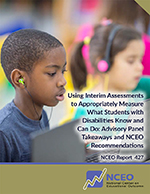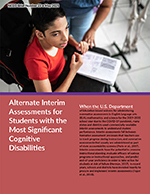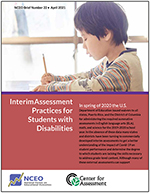Many states and districts are interested in using interim assessments. Interim assessments are used for a variety of purposes including measuring growth or progress, for instructional decision making, predicting summative assessment performance, and measuring whether a student meets a grade-level goal. Additionally there is interest in potentially using interim assessments to measure learning losses that may have occurred because of schooling disruptions that occurred as a result of the pandemic.
Little attention has been given to how to include some students with disabilities in these assessments in ways that produce valid results and support valid interpretations of those results. Further, there are federal requirements that all statewide and districtwide administrations of an assessment must have an alternate assessment, so states and districts that adopt interim assessments will need to implement approaches that are appropriate for students who participate in their alternate assessments.
NCEO recently published three resources which address interim assessments.
Using Interim Assessments to Appropriately Measure What Students with Disabilities Know and Can Do: Advisory Panel Takeaways and NCEO Recommendations (NCEO Report 427) presents a summary of a virtual meeting of an Interim Assessment Advisory Panel that was assembled by NCEO. The meeting purpose was to develop and disseminate guidance to state departments of education on how to enable all students with disabilities, including students with the most significant cognitive disabilities and English learners with disabilities, to participate in interim assessments in ways that yield valid inferences of what they know and can do. Advisors noted concerns and gaps about current interim assessments and their uses, suggested what should be, and proposed practical considerations for a better interim assessment system for each of five areas: (a) Participation; (b) Accessibility; (c) Role of academic standards; (d) Technical issues; and (e) Data use, interpretation, and reporting. Based on the advisors’ discussions, NCEO proposed seven recommendations for states and districts that use (or are considering use of) interim assessments:
- Obtain data on the participation of students with disabilities in interim assessments, and develop a plan for analyzing those data.
- Provide high-quality alternate interim assessments for students with the most significant cognitive disabilities.
- Provide a wide range of accessibility features and accommodations, including accommodations for students with sensory disabilities (e.g., braille, graphic organizers, sign language interpretation, etc.) and English learners with disabilities (e.g., glossaries, translations, etc.).
- Provide guidance on the provision of accessibility and accommodations.
- Provide transparency on the degree of alignment (or lack of alignment) to grade-level academic content standards of both general and alternate interim assessments.
- Provide documentation and evidence that interim assessments are properly designed to evoke the intended cognitive processes when administered to students with disabilities.
- Provide publicly available guidance on the appropriate and inappropriate uses of data in formats that meet the needs of intended audiences.
Alternate Interim Assessments for Students with the Most Significant Cognitive Disabilities (NCEO Brief 23), offers preliminary guidance for the development of interim alternate assessment options. Steps states and districts can take to develop an alternate interim assessment include:
- Clarify the purpose and use of the interim assessment for which an alternate is needed.
- Convene a stakeholder group to review proposed purpose and use, and to brainstorm what should be included in an alternate interim assessment and a potential assessment format.
- Work with assessment developers to create a blueprint for the assessment.
- Continue working with assessment developers to establish technical quality consistent with the Testing Standards.
The third publication, Interim Assessment Practices for Students with Disabilities (NCEO Brief 22), contains a scan of the interim assessment landscape, and is focused on the availability of documentation supporting the appropriateness of these assessments for students with disabilities.



